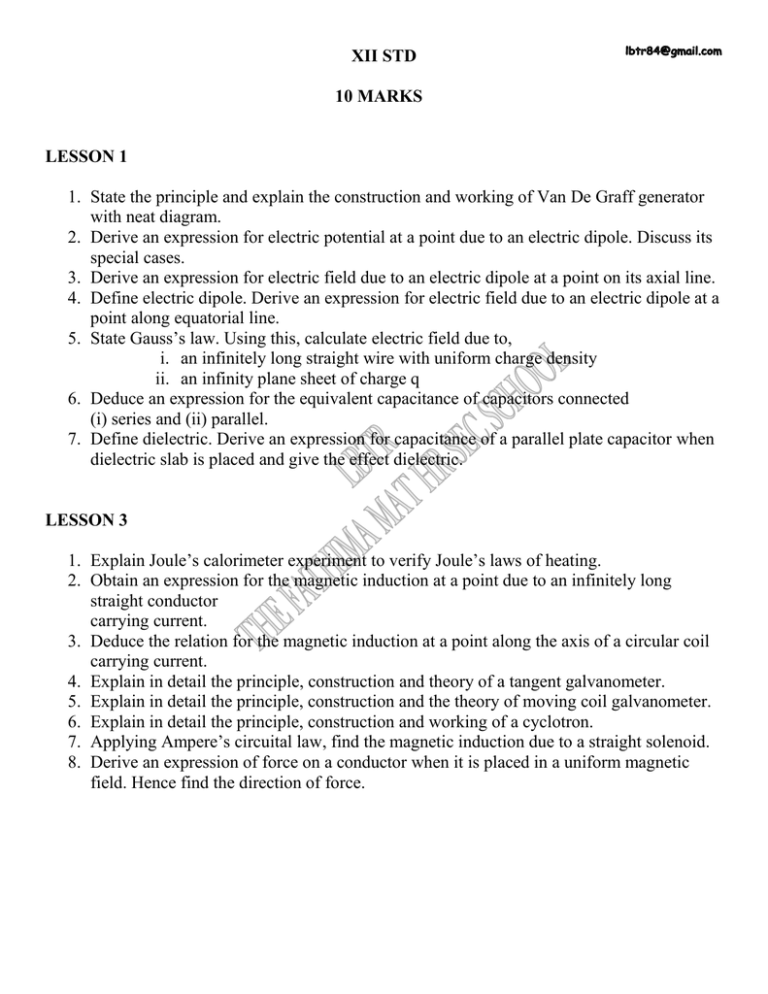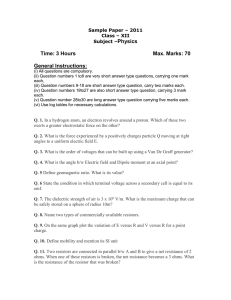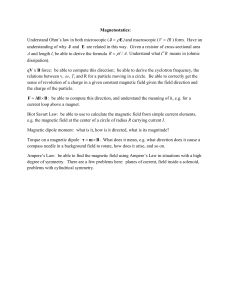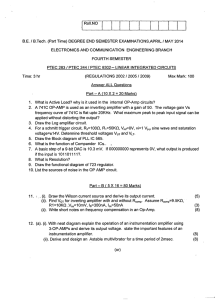10 Mark Questions
advertisement

XII STD 10 MARKS LESSON 1 1. State the principle and explain the construction and working of Van De Graff generator with neat diagram. 2. Derive an expression for electric potential at a point due to an electric dipole. Discuss its special cases. 3. Derive an expression for electric field due to an electric dipole at a point on its axial line. 4. Define electric dipole. Derive an expression for electric field due to an electric dipole at a point along equatorial line. 5. State Gauss’s law. Using this, calculate electric field due to, i. an infinitely long straight wire with uniform charge density ii. an infinity plane sheet of charge q 6. Deduce an expression for the equivalent capacitance of capacitors connected (i) series and (ii) parallel. 7. Define dielectric. Derive an expression for capacitance of a parallel plate capacitor when dielectric slab is placed and give the effect dielectric. LESSON 3 1. Explain Joule’s calorimeter experiment to verify Joule’s laws of heating. 2. Obtain an expression for the magnetic induction at a point due to an infinitely long straight conductor carrying current. 3. Deduce the relation for the magnetic induction at a point along the axis of a circular coil carrying current. 4. Explain in detail the principle, construction and theory of a tangent galvanometer. 5. Explain in detail the principle, construction and the theory of moving coil galvanometer. 6. Explain in detail the principle, construction and working of a cyclotron. 7. Applying Ampere’s circuital law, find the magnetic induction due to a straight solenoid. 8. Derive an expression of force on a conductor when it is placed in a uniform magnetic field. Hence find the direction of force. LESSON 4 1. Describe the principle, construction and working of a single – phase a.c generator. 2. Explain the principle of transformer. Discuss its construction and working. 3. A source of altemating emf is connected to a series combination of a resistor R an inductor L and a capacitor C. Obtain with the help of a vector diagram and impedance diagram, an expression for (i) the effective voltage (ii) the impedance (iii) the phase relationship between the current and the voltage. 4. Explain how emf is induced in a coil by changing its orientation with respect to the direction of magnetic field. 5. Obtain an expression for the current in an ac circuit containing a pure inductance. Find the phase relationship between voltage and current. 6. Obtain an expression for the current flowing in the circuit containing capacitance only to which an alternating emf is applied. Find the phase relationship between the current and voltage. LESSON 5 1. Explain the Raman scattering of light with the help of energy level diagram. 2. Derive an expression for bandwidth of interference fringes in Young’s double slit experiment. 3. Discuss the theory of interference in thin transparent film due to reflected light and obtain condition for the intensity to be maximum and minimum. 4. What are spectra? Explain the different type’s spectra. 5. On the basis of wave theory, explain total internal reflection. Write the condition for the total internal reflection to take place. LESSON 6 1. Explain the working of Ruby Laser with neat sketch. 2. State the postulates of Bohr atom model. Obtain an expression for the radius of the nth orbit of an electronbased on Bohr’s theory. 3. With the help of energy level diagram, explain the working of He-Ne laser. 4. Describe the J.J.Thomson method for determining the specific charge of an electron 5. State and obtain Bragg’s law. Explain how a Bragg’s spectrometer can be used to determine the wavelength of X-rays. LESSON 8 1. What are cosmic rays? Explain i. latitude effect of cosmic rays ii. altitude effect of cosmic rays. 2. Discuss the principle and action of a Bainbridge mass spectrometer to determine the isotopic masses. 3. Explain the construction and working of a Geiger – Muller counter 4. Define radioactive law of disintegration. Obtain an expression to deduce the amount of the radioactive substance present at any instant.Obtain the relation between half life and decay constant. LESSON 9 1. What is meant by feedback? Derive an expression for voltage gain of an amplifier with negative feedback? What are the advantages of negative feedback? 2. Sketch the circuit of Colpitt’s oscillator. Explain its working. 3. Describe an operational amplifier. Explain its action as (i) invertingamplifier and (ii) noninverting amplifier. 4. With a neat circuit diagram, explain the working of single stage CE amplifier with frequency response curve. 5. What is rectification? Explain the working of a bridge rectifier with necessary waveforms. LESSON 10 1. 2. 3. 4. With the help of block diagram, explain the function of a monochrome TV receiver. Make an analysis of amplitude modulated wave. Plot the frequency spectrum. With the help of block diagram, explain the function of a monochrome TV transmitter. Explain the principle and working of RADAR with block diagram.






